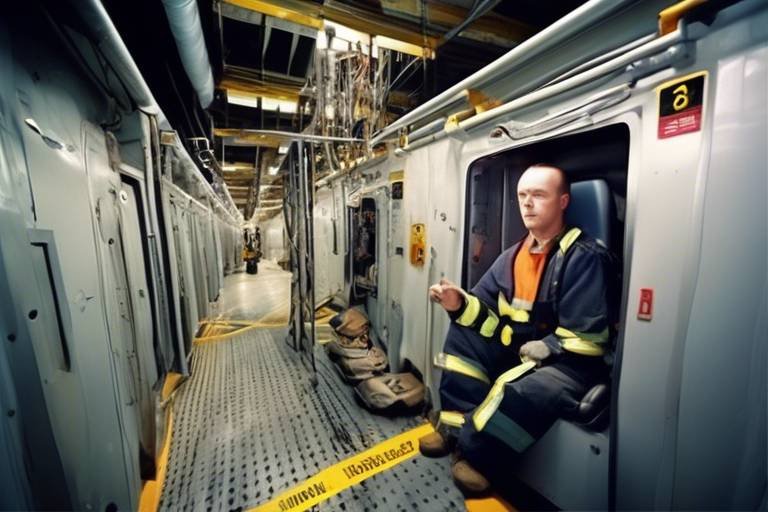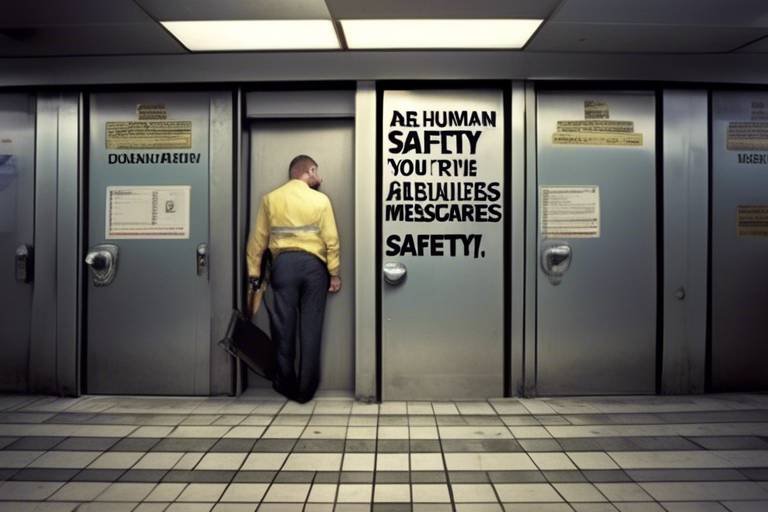Understanding Human Behavior - Key to Safety
In a world where safety is paramount, understanding human behavior is the key to creating environments that minimize risks and enhance well-being. Every day, we make countless decisions based on our perceptions, emotions, and social influences. These choices can either promote safety or lead to dangerous situations. So, what drives our behavior? How can we harness this knowledge to foster a safer society? This article dives deep into the critical relationship between human behavior and safety, examining the intricate factors that influence our actions and decision-making processes.
To truly grasp the connection between human behavior and safety, we must first delve into the psychological aspects at play. Our emotions, cognition, and the social influences surrounding us shape our behaviors significantly. For instance, when faced with a hazardous situation, our emotional responses can dictate our actions more than we might realize. Think about it: have you ever made a snap decision in a moment of panic? That’s your emotional brain taking the reins. Understanding these psychological factors can help us design better safety protocols that align with how humans naturally think and feel.
Risk perception is a fascinating area of study that reveals how individuals assess potential dangers. It’s not just about the actual risk; it’s about how we perceive it. Cognitive biases, such as overconfidence or the optimism bias, can lead individuals to underestimate risks, resulting in unsafe choices. For example, many people believe that accidents only happen to others, which can lead them to engage in risky behaviors. By fostering informed decision-making, we can counteract these biases and promote safer choices. But how do we achieve this? Through education and awareness campaigns that highlight the real risks associated with certain behaviors.
Emotions play a crucial role in our decision-making processes, especially in high-stakes situations. When our adrenaline is pumping, or fear sets in, our ability to think rationally can diminish. This is why managing emotional responses is vital for enhancing safety. For instance, in emergency situations, individuals might freeze or panic instead of taking appropriate action. Training programs that incorporate emotional management strategies can significantly reduce risky behaviors. It's akin to teaching someone how to swim; knowing how to manage fear can be just as important as knowing the strokes.
Fear is a powerful motivator, but it can also lead to irrational decisions. Understanding how fear influences behavior allows us to design interventions that mitigate its negative effects. For example, safety drills can help individuals become more familiar with emergency procedures, reducing fear during real crises. When people know what to expect, they’re more likely to act calmly and effectively. It’s like rehearsing for a play; the more familiar you are with your lines, the less anxious you feel when it’s showtime.
High-stress environments can severely impair judgment and performance. Recognizing the stressors that individuals face in various situations is crucial for developing better safety protocols. For instance, employees in high-pressure jobs may overlook safety measures due to stress. By implementing stress management techniques and providing training that focuses on maintaining performance under pressure, organizations can enhance both individual and group responses to safety challenges. Think of it this way: a well-oiled machine performs best when it’s not overloaded with unnecessary pressure.
Our behavior is not only shaped by our internal states but also by the social context in which we find ourselves. Peer pressure, cultural norms, and group dynamics can significantly influence safety-related behaviors. For example, if a group of friends decides to engage in risky behavior, an individual may feel compelled to follow suit, even if they know it’s unsafe. Understanding these social influences can help us create environments that promote safe practices. It’s essential to foster a culture where safety is valued and encouraged, much like how a supportive community can uplift its members.
To improve safety, we must implement effective behavioral interventions. These can range from comprehensive training programs to awareness campaigns that educate individuals about safe practices. For instance, organizations can benefit from policies that reward safe behaviors, creating a culture of safety. By reinforcing positive behaviors, we can encourage individuals to make safer choices consistently.
Positive reinforcement is a powerful tool in shaping behavior. Programs that reward safe practices have been shown to lead to improved safety outcomes. For example, consider a workplace that recognizes employees for adhering to safety protocols. This not only boosts morale but also encourages others to follow suit. It’s akin to a snowball effect; once one person is recognized for their safe behavior, others are likely to emulate that behavior to gain similar recognition.
Effective training and education are crucial for enhancing safety awareness. Organizations must implement various strategies to educate individuals about safe practices and behaviors. This could include workshops, simulations, and ongoing training sessions that reinforce the importance of safety. Just like mastering a skill, continuous learning is vital to maintaining a high standard of safety awareness. Remember, knowledge is power, and in the realm of safety, it can be life-saving.
Looking ahead, emerging trends in understanding human behavior related to safety are exciting. Technology is playing an increasingly significant role in shaping behaviors, from wearable safety devices to apps that promote safe practices. Additionally, the importance of continuous learning and adaptation cannot be overstated. As our understanding of human behavior evolves, so too must our safety strategies. Just as the world changes, so should our approaches to ensuring safety.
- What are some common cognitive biases that affect safety decisions? Cognitive biases such as optimism bias, overconfidence, and confirmation bias can lead individuals to underestimate risks and make unsafe choices.
- How can emotions impact safety? Emotions like fear and stress can impair judgment and lead to risky behaviors, especially in high-stakes situations.
- What role does social influence play in safety behaviors? Social influences, including peer pressure and cultural norms, can significantly affect individuals' safety-related behaviors.
- What are some effective behavioral interventions for safety? Positive reinforcement techniques, training programs, and awareness campaigns are examples of interventions that can improve safety outcomes.

The Psychology of Human Behavior
Understanding the psychology of human behavior is like peeling an onion; each layer reveals something new and often unexpected. At the core, our behavior is influenced by a myriad of factors, including emotions, cognition, and the social environment. These elements intertwine to create a complex web that dictates how we act in various situations, particularly when it comes to safety. For instance, have you ever wondered why some people take risks that seem downright foolish? Often, it's a combination of their emotional state and the cognitive biases that cloud their judgment.
Emotions, such as fear and excitement, play a crucial role in shaping our decisions. When faced with a dangerous situation, our emotional responses can either propel us to safety or lead us into harm’s way. This is where understanding the psychology of human behavior becomes vital. It’s not just about knowing what people do, but also understanding why they do it. For example, fear can trigger a fight-or-flight response, which might cause someone to react impulsively, potentially compromising their safety.
Moreover, our cognitive processes—how we think and perceive risks—are equally important. Cognitive biases, such as overconfidence or the optimism bias, can distort our perception of reality. We might think, “It won’t happen to me,” leading us to engage in unsafe behaviors. In fact, studies show that individuals often underestimate the likelihood of negative outcomes, which can result in dangerous choices. This highlights the necessity of fostering an informed mindset, where individuals are educated about the risks they face.
Social influences also play a significant role in shaping our behaviors. The people we surround ourselves with, the cultural norms we adhere to, and even the dynamics within a group can impact our choices. For instance, if everyone in a group is engaging in risky behavior, an individual may feel pressured to conform, disregarding their better judgment. This phenomenon is known as peer pressure, and it can have serious implications for safety. Understanding these social dynamics can help in designing interventions that promote safer practices.
To illustrate this further, consider the following table that summarizes the key psychological factors affecting human behavior in safety contexts:
| Factor | Description |
|---|---|
| Emotions | Influence decision-making and can lead to impulsive actions. |
| Cognitive Biases | Distort perceptions of risk and safety, leading to poor choices. |
| Social Influences | Peer pressure and cultural norms can encourage unsafe behaviors. |
In conclusion, understanding the psychology of human behavior is essential for enhancing safety. By recognizing the emotional, cognitive, and social factors at play, we can develop more effective strategies to promote safe practices. It’s about creating an environment where individuals feel empowered to make informed decisions, free from the distortions of fear and social pressure. So, the next time you encounter a risky situation, take a moment to reflect on the psychological factors influencing your choices; it might just save your life!
- What are cognitive biases? Cognitive biases are systematic patterns of deviation from norm or rationality in judgment, which can lead to illogical interpretations and decisions.
- How do emotions affect decision-making? Emotions can significantly influence our choices, often leading to impulsive actions that may not align with logical reasoning.
- What role does social influence play in safety? Social influences can pressure individuals to conform to group behaviors, which may not always be safe, highlighting the importance of fostering a culture of safety.

Risk Perception and Decision Making
When it comes to safety, understanding risk perception and the decision-making process is absolutely vital. Every day, we are faced with choices that can either enhance our safety or put us at risk. But what exactly influences these choices? The answer lies in the intricate web of cognitive biases, emotions, and social pressures that shape our perceptions of risk. For instance, have you ever noticed how some people seem to disregard safety warnings while others are overly cautious? This discrepancy often stems from how individuals perceive risk, which can be influenced by personal experiences, cultural background, and even the media.
At the heart of risk perception is the idea that we don’t always assess danger rationally. Our brains are wired to make quick judgments, and this can lead to cognitive biases that skew our understanding of risk. For example, the availability heuristic suggests that we tend to overestimate the likelihood of events that are more memorable or dramatic. If we hear about a plane crash on the news, we might irrationally fear flying, even though statistically, it remains one of the safest modes of transportation. This illustrates how emotions and media portrayal can distort our risk assessment.
Moreover, decision-making often occurs under pressure, which can lead to hasty conclusions. In high-stress situations, individuals might rely on gut feelings rather than thorough analysis. This is where the role of emotions becomes even more critical. Fear, for instance, can either paralyze us or prompt us to take swift action. Understanding how emotions influence our decisions can help us develop better strategies for making informed choices in critical situations.
To mitigate the negative effects of these biases, it’s essential to foster an environment that encourages informed decision-making. This means providing individuals with accurate information and training that enhances their ability to assess risks effectively. For organizations, implementing comprehensive training programs can significantly improve the decision-making processes of employees. When people are educated about potential hazards and the best practices for avoiding them, they are more likely to make choices that prioritize safety.
Consider the following strategies that can enhance risk perception and decision-making:
- Education: Regular training sessions can equip individuals with the knowledge they need to recognize risks accurately.
- Open Communication: Encouraging discussions about safety can help individuals feel more comfortable sharing their concerns and insights.
- Real-Life Scenarios: Using simulations or role-playing can help individuals practice decision-making in a controlled environment.
In conclusion, understanding the dynamics of risk perception and decision-making is crucial for fostering a culture of safety. By recognizing the cognitive biases that can cloud judgment and implementing strategies to promote informed choices, we can significantly improve safety outcomes in various contexts. Whether it's in the workplace, at home, or in public spaces, being aware of how we perceive risk can lead to better decisions that ultimately keep us safe.
- What is risk perception? Risk perception refers to the subjective judgment individuals make regarding the characteristics and severity of a risk.
- How do cognitive biases affect decision-making? Cognitive biases can lead to flawed reasoning and poor decision-making by distorting our perception of risks and outcomes.
- Why is education important for safety? Education helps individuals understand risks better and equips them with the tools to make informed decisions that enhance safety.

The Role of Emotions in Safety
Emotions play a crucial role in shaping our decisions and actions, especially when it comes to safety. Imagine you're driving down a busy road, and suddenly, a car swerves into your lane. Your heart races, and in that split second, your emotional response kicks in. This is where the interplay between emotions and safety becomes evident. Emotions can either cloud our judgment or guide us towards making safer choices. Understanding this relationship is vital for creating safer environments.
When we talk about emotions in the context of safety, we often think about fear, anxiety, and stress. These feelings can significantly influence our decision-making processes. For instance, fear can lead to over-cautious behavior, making individuals hesitant to take necessary risks, while a lack of fear can result in reckless actions. It’s a delicate balance. Recognizing how emotions impact our behavior is essential for developing effective safety strategies.
To illustrate this further, let’s take a look at some common emotional responses and their implications for safety:
- Fear: While fear can protect us from danger, excessive fear can lead to avoidance behaviors. For example, someone who fears heights may avoid climbing ladders, which could hinder their ability to perform certain jobs safely.
- Anxiety: High levels of anxiety can impair cognitive function, leading to poor decision-making. In high-stress situations, individuals may overlook critical safety protocols.
- Confidence: A healthy level of confidence can enhance performance, but overconfidence can lead to risky behaviors. For instance, a worker who feels invincible may neglect safety gear, increasing the likelihood of accidents.
Managing these emotional responses is key to enhancing safety. Training programs that focus on emotional intelligence can equip individuals with the tools to recognize and regulate their emotions. For example, teaching people to identify when they are feeling anxious or fearful can empower them to take a step back and assess the situation more rationally. This self-awareness can lead to better decision-making and ultimately, a safer environment.
Moreover, creating a supportive atmosphere where individuals feel safe to express their emotions can foster open communication about safety concerns. When team members can discuss their fears or anxieties without judgment, it leads to a more collaborative approach to safety. This not only enhances individual well-being but also strengthens the overall safety culture within an organization.
In conclusion, emotions are a double-edged sword when it comes to safety. They can either bolster our protective instincts or lead us astray. By understanding and managing our emotional responses, we can significantly improve safety outcomes in various contexts. The journey towards safety is not just about protocols and procedures; it’s also about understanding the human element—our emotions.

Fear and Its Influence
Fear is a powerful emotion that can drastically alter our behavior and decision-making processes. Think about the last time you felt afraid; perhaps it was during a near-miss accident or while watching a suspenseful movie. In such moments, our bodies react instinctively, often overriding rational thought. This instinctual response can be both a blessing and a curse when it comes to safety. On one hand, fear can trigger a fight-or-flight response, prompting individuals to take immediate action to protect themselves. On the other hand, it can lead to irrational decisions that compromise safety. For example, someone might panic and flee in a situation where a calm assessment would be more beneficial.
To understand the influence of fear on behavior, we can break it down into several key areas:
- Immediate Reactions: In a frightening situation, the body's adrenaline response can lead to quick, sometimes unsafe actions. This instinctual behavior can prevent individuals from thinking critically about their choices.
- Long-Term Effects: Prolonged exposure to fear can create a culture of anxiety, leading to avoidance behaviors. For instance, someone who has experienced a traumatic event may avoid certain environments, impacting their overall safety.
- Social Dynamics: Fear can also be contagious. If one person reacts with panic, it can trigger a chain reaction, causing others to behave similarly without assessing the actual risk involved.
Understanding fear's influence is crucial for designing effective safety interventions. By recognizing how fear can distort perception and judgment, safety professionals can create strategies that help individuals manage their emotional responses. For instance, training programs that incorporate stress management techniques can empower individuals to remain calm and collected in high-pressure situations. Moreover, fostering an environment where open communication is encouraged can help mitigate irrational fears and promote safer practices.
In summary, fear is a double-edged sword in the realm of safety. While it can serve as a protective mechanism, it can also lead to dangerous behaviors if not properly managed. By acknowledging and addressing the impact of fear, we can develop more effective safety protocols that not only protect individuals but also enhance overall safety culture.
- What role does fear play in decision-making? Fear can lead to quick, instinctual reactions that may not be rational, often resulting in unsafe choices.
- How can we manage fear in high-stress situations? Techniques such as breathing exercises, mindfulness, and training can help individuals remain calm and make informed decisions.
- Can fear be beneficial in safety contexts? Yes, fear can motivate individuals to take necessary precautions, but it needs to be managed effectively to avoid panic-driven decisions.

Stress and Performance
Stress is one of those sneaky little gremlins that can creep into our lives and wreak havoc on our performance. Imagine trying to run a marathon while someone is constantly yelling in your ear—this is what stress can feel like in high-pressure situations. When faced with stress, our bodies go into fight-or-flight mode, releasing hormones like adrenaline and cortisol. While these reactions can be beneficial in short bursts, prolonged exposure to stress can lead to decreased performance and poor decision-making.
In many high-stakes environments, such as healthcare, aviation, or emergency services, the consequences of stress-induced errors can be dire. Studies have shown that stress can impair cognitive functions, such as attention, memory, and problem-solving abilities. For instance, a pilot dealing with a stressful situation may miss critical information that could affect the safety of the flight. This is why understanding how stress impacts performance is crucial for developing effective safety protocols.
One of the most significant challenges is identifying the stressors that individuals face. These can range from external factors, like tight deadlines and high expectations, to internal factors, such as self-doubt and anxiety. By recognizing these stressors, organizations can implement strategies to mitigate their impact. For example, regular training sessions can help employees build resilience, allowing them to handle stress more effectively when it arises.
Furthermore, fostering a supportive work environment can significantly enhance performance under stress. When employees feel valued and supported, they are more likely to perform well, even in high-pressure situations. This can include:
- Providing access to mental health resources
- Encouraging open communication about stress and its effects
- Implementing regular breaks to recharge
In conclusion, understanding the relationship between stress and performance is essential for fostering a safer and more effective work environment. By addressing stressors and promoting a culture of support, organizations can enhance overall performance and safety outcomes.
- What are common signs of stress in the workplace? Common signs include increased absenteeism, decreased productivity, and changes in behavior or mood.
- How can I manage stress effectively? Techniques such as mindfulness, exercise, and time management can help in managing stress levels.
- What role does communication play in stress management? Open communication can help identify stressors and foster a supportive environment, which is crucial for managing stress.

Social Influences on Behavior
When we think about human behavior, it's impossible to overlook the profound impact that social influences have on our actions. Ever noticed how you might act differently in a group compared to when you're alone? That's not just you; it's a common phenomenon shaped by the people around us. From peer pressure to cultural norms, our social environment plays a pivotal role in shaping our decisions and behaviors, especially concerning safety.
Consider the power of peer pressure. This influence can be incredibly strong, particularly among younger individuals. When friends or colleagues engage in risky behaviors, it can create a sense of urgency to conform, even if it goes against one's better judgment. For instance, if a group decides to skip safety gear while engaging in an extreme sport, an individual may feel compelled to join in, disregarding personal safety for the sake of group acceptance. This illustrates how social dynamics can lead to dangerous choices.
Moreover, cultural norms significantly influence behavior. Different cultures have varying perceptions of safety and risk-taking. In some cultures, taking risks is celebrated and seen as a sign of bravery, while in others, caution is prioritized. These cultural attitudes can shape individual behavior in ways that either promote or hinder safety. For example, in a workplace where safety protocols are not culturally emphasized, employees may neglect essential safety practices, believing that such measures are unnecessary.
Group dynamics also play a crucial role in shaping behavior. The phenomenon known as groupthink can lead teams to make faulty decisions because the desire for harmony and conformity overrides realistic appraisal of alternatives. This can be particularly dangerous in environments where safety is paramount, such as in healthcare or construction. When team members prioritize consensus over critical thinking, it can lead to catastrophic outcomes.
To foster a culture of safety, organizations and communities must actively work to understand and address these social influences. This can include:
- Creating an open environment where individuals feel safe to voice concerns about risky behaviors.
- Implementing training programs that emphasize the importance of safety, tailored to the specific cultural context of the group.
- Encouraging positive role models who exemplify safe behaviors, thus promoting a shift in group norms.
By recognizing the power of social influences, we can better understand how they affect our behaviors and decision-making processes. Addressing these influences not only enhances individual safety but also cultivates a broader culture of safety within communities and organizations.

Behavioral Interventions for Safety
When it comes to ensuring safety in various environments, understanding human behavior is not just beneficial; it's essential. Behavioral interventions are strategies designed to influence people's actions and decisions positively, ultimately leading to a safer atmosphere. These interventions can take many forms, from training programs that educate individuals about safe practices to awareness campaigns that highlight the importance of safety in daily life. But how do these interventions work, and what makes them effective? Let's dive deeper.
One of the most effective ways to enhance safety is through comprehensive training programs. These programs are not just about imparting knowledge; they are about creating an engaging learning experience that resonates with participants. For example, many organizations have adopted interactive training sessions that incorporate real-life scenarios, enabling individuals to practice their responses to potential hazards. This hands-on approach not only improves retention but also builds confidence in handling critical situations. Furthermore, incorporating technology, such as virtual reality simulations, can provide immersive experiences that prepare individuals for real-world challenges.
In addition to training, awareness campaigns play a crucial role in behavioral interventions. These campaigns are designed to inform and educate the public about safety risks and the importance of adopting safe behaviors. A well-crafted campaign utilizes various media—social media, posters, workshops, and community events—to reach a broad audience. For instance, a campaign promoting fire safety might include interactive workshops, distribution of informative flyers, and social media challenges that encourage people to share their fire safety tips. The goal is to create a culture of safety where individuals feel empowered to take responsibility for their well-being and that of others.
An essential aspect of behavioral interventions is the concept of positive reinforcement. By rewarding safe behaviors, organizations can encourage individuals to continue making safe choices. For example, a workplace might implement a reward system where employees receive recognition or small incentives for adhering to safety protocols. This not only motivates employees but also fosters a community of safety-minded individuals who support one another in making safe decisions. Research has shown that positive reinforcement can significantly impact behavior change, making it a powerful tool in safety interventions.
Moreover, it's important to recognize the role of policy changes in enhancing safety. Policies that prioritize safety can create an environment where safe practices are the norm rather than the exception. For instance, implementing strict safety regulations in workplaces can compel organizations to adopt better safety measures and provide adequate training for employees. Additionally, policies that encourage reporting unsafe conditions without fear of retaliation can lead to a more proactive approach to safety, allowing organizations to address issues before they escalate into serious problems.
Ultimately, the effectiveness of behavioral interventions hinges on understanding the underlying factors that drive human behavior. By considering emotional responses, social influences, and cognitive biases, organizations can tailor their interventions to address the specific needs of their audience. As we continue to explore innovative strategies for improving safety, the focus must remain on creating a supportive environment that encourages individuals to prioritize safety in their daily lives.
- What are behavioral interventions? Behavioral interventions are strategies designed to influence individuals' actions and decisions positively to enhance safety.
- How do training programs improve safety? Training programs provide individuals with the knowledge and skills needed to respond effectively to potential hazards, often through interactive and engaging methods.
- What role does positive reinforcement play in safety? Positive reinforcement encourages individuals to continue safe behaviors by rewarding them for adhering to safety protocols.
- Why are awareness campaigns important? Awareness campaigns educate the public about safety risks and promote a culture of safety, empowering individuals to take responsibility for their well-being.
- How can policy changes enhance safety? Policy changes can create an environment that prioritizes safety, encouraging organizations to adopt better safety measures and training programs.

Positive Reinforcement Techniques
When it comes to promoting safe behaviors, positive reinforcement is a powerful tool that can lead to significant improvements in safety outcomes. This technique involves rewarding desirable behaviors to encourage their repetition, creating a culture where safety is prioritized. Imagine a workplace where employees are recognized not just for their productivity but also for their commitment to safety—this type of environment fosters a sense of responsibility and motivation to adhere to safety protocols.
One effective method of implementing positive reinforcement is through recognition programs. These programs can range from simple shout-outs in a team meeting to more structured systems like safety awards or bonus incentives. For instance, a company might establish a monthly award for the team that demonstrates the best safety practices. This not only motivates individuals to act safely but also encourages teamwork and accountability among peers.
Another technique is the use of feedback loops. When individuals receive immediate and specific feedback about their safety-related actions, they are more likely to understand the impact of their behavior. For example, if a safety officer observes an employee wearing their protective gear correctly, a quick acknowledgment such as, “Great job on wearing your helmet today! It really sets a good example for the team,” reinforces that behavior. This kind of immediate recognition makes the employee feel valued and encourages them to continue practicing safe behaviors.
Moreover, organizations can utilize incentive programs that reward safe behaviors over time. These can include points systems where employees earn points for consistent adherence to safety practices, which can later be redeemed for rewards. This not only motivates individuals but also creates a friendly competition among employees to prioritize safety. A well-structured incentive program can lead to a marked decrease in workplace accidents and incidents.
To illustrate the effectiveness of positive reinforcement, consider the following table that summarizes key strategies and their outcomes:
| Technique | Description | Expected Outcome |
|---|---|---|
| Recognition Programs | Acknowledge individuals or teams for safe behaviors. | Increased motivation and accountability. |
| Feedback Loops | Provide immediate feedback on safety actions. | Improved understanding and reinforcement of safe practices. |
| Incentive Programs | Reward consistent safe behaviors with points or prizes. | Enhanced engagement and reduced accidents. |
By integrating these positive reinforcement techniques into safety programs, organizations can not only enhance compliance with safety protocols but also cultivate a culture of safety where individuals feel empowered and encouraged to prioritize their well-being and that of their colleagues. In essence, when people are recognized for doing the right thing, they are more likely to continue doing it, leading to a safer and more productive environment.
In conclusion, positive reinforcement is not just about rewarding good behavior; it’s about creating a supportive atmosphere that values safety. It's essential for organizations to understand that investing in these techniques can yield significant returns in terms of employee safety and overall workplace morale.
- What is positive reinforcement? Positive reinforcement is a behavioral technique that involves rewarding desired behaviors to encourage their recurrence.
- How does positive reinforcement improve safety? By recognizing and rewarding safe behaviors, individuals are motivated to continue those behaviors, leading to a safer environment.
- Can positive reinforcement be applied in any industry? Yes, positive reinforcement techniques can be adapted to fit various industries and workplace settings.
- What are some examples of positive reinforcement? Examples include recognition programs, feedback loops, and incentive systems that reward safe practices.

Training and Education Strategies
When it comes to enhancing safety, effective training and education are paramount. Think of safety training as the foundation of a sturdy building; without it, everything can come crashing down. The goal here is to equip individuals with the knowledge and skills necessary to recognize hazards and respond appropriately. This isn’t just about memorizing rules; it’s about fostering a culture of safety where everyone feels empowered to act.
One of the most effective strategies involves interactive training sessions. These sessions can include simulations that mimic real-life scenarios, allowing participants to practice their responses in a controlled environment. Imagine a firefighter training in a simulated fire; the adrenaline and urgency they experience help them prepare for actual emergencies. Similarly, engaging participants through role-playing or hands-on activities can significantly enhance their learning experience and retention of safety protocols.
Moreover, incorporating technology into training programs can be a game changer. Virtual reality (VR) and augmented reality (AR) are emerging tools that provide immersive experiences, making safety training not only more engaging but also more effective. For instance, VR can transport trainees into a hazardous environment where they can learn to navigate dangers without the real-world risks. This type of training can be particularly beneficial in high-stakes industries like construction or healthcare.
Another critical aspect of training is the frequency and consistency of education. Safety is not a one-time lesson; it should be an ongoing conversation. Regular refresher courses ensure that employees stay updated on the latest safety practices and protocols. Consider implementing a monthly safety meeting where team members can discuss recent incidents, share insights, and reinforce the importance of safety in their daily routines.
To further enhance safety awareness, organizations can utilize multimedia resources. Videos, infographics, and interactive online modules can cater to different learning styles, making it easier for everyone to grasp essential safety concepts. For example, a quick video demonstrating proper lifting techniques can be more effective than a lengthy manual. By diversifying training methods, you can keep participants engaged and improve knowledge retention.
Finally, it’s crucial to foster a feedback-rich environment. Encourage participants to share their thoughts on training sessions and suggest improvements. This not only helps refine the training process but also makes individuals feel valued and heard. When employees see that their input leads to tangible changes, they are more likely to take safety seriously.
In summary, implementing that are interactive, technology-driven, frequent, multimedia-rich, and feedback-oriented can significantly enhance safety outcomes. By investing in your team’s safety education, you’re not just protecting them; you’re cultivating a culture of safety that can ripple throughout your organization.
- What is the importance of safety training? Safety training is essential for equipping employees with the knowledge and skills needed to identify and respond to hazards effectively, thereby reducing the risk of accidents.
- How often should safety training be conducted? Regular training sessions should be held, ideally on a monthly basis, to ensure that employees remain knowledgeable about safety protocols and practices.
- Can technology improve safety training? Yes, utilizing tools like virtual reality and online modules can enhance engagement and retention, making training more effective.
- How can feedback improve safety training? Gathering feedback from participants allows organizations to refine their training programs, ensuring they meet the needs of employees and address any gaps in knowledge.

Future Trends in Safety and Behavior
As we look to the horizon, the intersection of technology and human behavior is poised to redefine safety protocols across various sectors. With advancements in artificial intelligence and machine learning, we can now analyze behavioral patterns with unprecedented accuracy. Imagine a world where predictive analytics can anticipate unsafe behaviors before they occur, allowing organizations to intervene proactively. This isn't just a fantasy; it's becoming a reality. The future holds a treasure trove of possibilities, where understanding human behavior is not just reactive but anticipatory.
Moreover, wearable technology is making waves in safety management. Devices that monitor physiological indicators such as heart rate and stress levels can provide real-time feedback to users, alerting them to potential dangers. For instance, a construction worker wearing a smart helmet equipped with sensors can receive immediate notifications if their stress levels spike, indicating that they might be at risk of making poor decisions. This integration of health monitoring into safety protocols signifies a shift towards a more holistic approach to safety, where the well-being of individuals is prioritized.
Another exciting trend is the rise of virtual reality (VR) and augmented reality (AR) in training programs. These immersive technologies allow individuals to experience high-risk scenarios in a controlled environment, enhancing their decision-making skills without the real-world consequences. Picture this: a firefighter training in a VR simulation that mimics a raging inferno, providing them with the opportunity to practice their responses and strategies in a safe space. Such innovative training techniques not only improve skill sets but also boost confidence, ultimately leading to safer outcomes.
Furthermore, the role of social media and online communities cannot be overlooked. Platforms that promote safety awareness and share best practices are becoming essential tools in shaping behavior. By harnessing the power of social influence, organizations can create campaigns that resonate with individuals on a personal level. For example, a viral challenge encouraging safe driving practices can spread rapidly, leveraging peer pressure positively to foster a culture of safety among young drivers.
In addition to these technological advancements, there is a growing emphasis on continuous learning and adaptation within organizations. Safety is no longer viewed as a one-time training event but as an ongoing process. Companies are increasingly adopting a mindset of flexibility, where they regularly assess their safety protocols and adjust them based on new insights and data. This approach not only enhances safety but also cultivates a culture of accountability and responsibility among employees.
As we move forward, it’s crucial to remember that the future of safety lies in collaboration. By bringing together diverse stakeholders—employees, management, technology experts, and safety professionals—we can create comprehensive strategies that address the multifaceted nature of human behavior. This collaborative approach will ensure that safety measures are not only effective but also sustainable in the long run.
- What role does technology play in enhancing safety? Technology aids in monitoring behaviors, predicting risks, and providing immersive training experiences that improve decision-making.
- How can wearable devices improve safety? Wearable devices can monitor physiological indicators and alert users to potential dangers, helping them make safer choices.
- What is the importance of social media in safety awareness? Social media can be used to spread safety messages and best practices rapidly, influencing behavior positively through community engagement.
- Why is continuous learning essential for safety? Continuous learning allows organizations to adapt their safety protocols based on new insights, ensuring they remain effective and relevant.
Frequently Asked Questions
- What is the relationship between human behavior and safety?
Human behavior plays a crucial role in safety as it influences decision-making and risk perception. Understanding how emotions, cognitive biases, and social influences shape our actions can help create safer environments. By analyzing behavioral patterns, we can implement strategies that promote safe practices.
- How do emotions affect decision-making in safety contexts?
Emotions significantly impact how we make decisions, especially in high-stress situations. For instance, fear can lead to panic, causing individuals to make unsafe choices. Recognizing and managing these emotional responses is essential for enhancing safety and reducing risky behaviors.
- What role does social influence play in safety behaviors?
Social influences, such as peer pressure and cultural norms, can greatly affect safety-related behaviors. People are often swayed by the actions and attitudes of those around them, which can either promote safe practices or lead to dangerous choices. Understanding this dynamic can help in designing effective interventions.
- What are some effective behavioral interventions for improving safety?
Effective behavioral interventions include training programs, awareness campaigns, and policy changes that encourage safe practices. Positive reinforcement techniques, where safe behaviors are rewarded, have shown to improve safety outcomes significantly. Education strategies are also vital for raising awareness about safety practices.
- How can technology influence human behavior related to safety?
Technology plays an increasingly important role in shaping human behavior regarding safety. From safety apps that provide real-time alerts to virtual reality training programs that simulate hazardous environments, technology can enhance awareness and preparedness, leading to improved safety outcomes.
- What future trends should we expect in safety and human behavior?
Future trends in safety will likely focus on continuous learning and adaptation, emphasizing the importance of understanding human behavior. Innovations in technology and data analytics will help organizations better predict and influence safe behaviors, creating a more proactive approach to safety management.



















